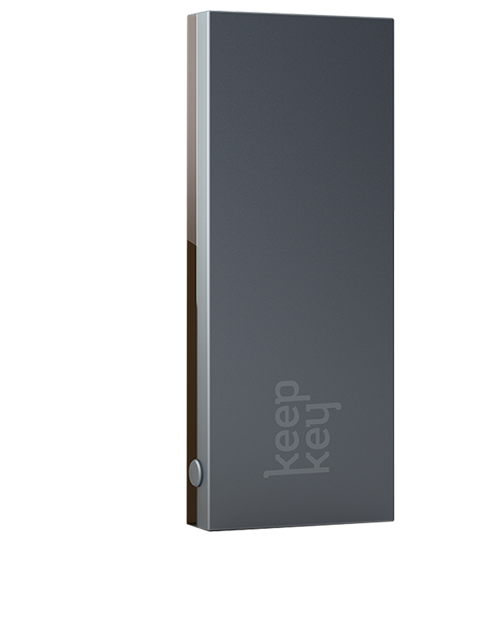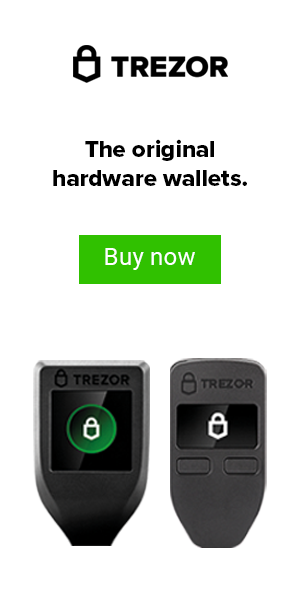You Might also like
-
KeepKey Vs. Trezor Vs. Ledger: Which One Should I Buy? (2020)
In this review, I will go over all 3 primary hardware wallets and see the show down of KeepKey Vs. Trezor Vs. Ledger. People always ask me when they realize they need to start taking their private key security seriously is “Which hardware wallet should I buy?“ This questions has been presented to me hundreds, if not thousands of time, and there is no one real “clear” answer.


It ultimately depends on which coins you want to store and how you want to access them. Do you plan on trading your coins often? Are you simply just trying to “buy and hold” for several months and several years, like a set and forget situation? Are you planning on using the wallet to “bake” or use to contribute to the blockchain on proof-of-stake (POS) networks?
While these are all valid questions, I personally have all 3 wallets and use them regularly. Why? Well, aside from being in the industry, and needing to stay up to date on these devices and their features and capabilities, the main reason is to diversify. What do I mean by this?
Well, if you have (or plan to have) significant holdings, it is smart not to have all of your coins or private keys on one wallet, just in case. Now I’ve created a free e-book that explains how to avoid this which you can get for free HERE, but ultimately if you are in the market for a wallet for the first time, I will tell you the wallet I like to use the best right now in May of 2019.
KeepKey VS. Trezor VS. Ledger
Stay tuned below for the final result, but I go over some pros and cons of each device below. They all are very secure and safe to use, but it really just comes down to preference and really how often you decide to interact with the device. Let’s get right to it!
#1 TREZOR
There are two versions of Trezor: Trezor One and Trezor Model T. The former is the entry level device that came out 2013 and has since received regular firmware upgrades enhancing it’s security and adding new software support for native and 3rd party applications for new coins. In 2018, they released their 2nd-gen product called the “Model T“.
The latter is a larger device with touch screen and is operated by a “Beta” wallet that supports over 1,000 coins between it’s native applications and 3rd party integration. Most recently, they added NATIVE support (which is a huge upgrade in my opinion) for Ethereum (ETH) and Ethereum Classic (ETC). This means it is connected to its unique application that was custom designed by Trezor to manage your ETH accounts directly in the app. Previously, any ETH or ERC-20 based token required to use a 3rd party wallet, which was annoying and cumbersome.
I understand there is a lot of development work that goes into creating and managing any native app, but Ledger and Trezor already had native support for this, (as they should) considering it’s been in the top 3 coins by market cap consistently for years.
Trezor Model T however, is a massive upgrade and adds not only native support for multiple coins, but has added security in the form of a PIN entered in on the touch screen of the device instead of the web app used on the web application. This upgraded device was used for several new features including a password manager and multiple additional security options and ease of use for recovery options on the device itself. Very powerful. Below is the overall feeling I have about the device(s) and the overall team behind them.


Bottomline: They have upgraded some basic functionality, which is good, and to their credit they have added support for some coins that really need it, such as Monero and Tether. This is of course when their team collaborates and helps build a supported wallet to tie into their code base. They have been building a foundation for the future and that is going to work in their favor as soon as each coin’s respective development team decides to catch up.
-Binance Coin (BNB)
-Monero (XMR)
-Cardano (ADA)
-Ravencoin (RVN)
-Tether (USDT) *Stable coin*
#2 KEEPKEY
Keepkey has always been a favorite of mine, as it’s a solid design and very sleek and stable frame that just feels good when you hold it in your hands. Now let’s get into the nitty-gritty. For years, Keepkey only supported: Bitcoin, Litecoin, Ethereum, Namecoin, Dogecoin, and Dash.
For a hardware wallet that needs to compete in this market place, that needed a serious upgrade. Luckily, they have been making some AMAZING changes and not only added a ton of ERC-20 Support, but more importantly, they are revamping their entire platform to have one fluid, seamless application that integrates all of their core services (See my previous post for details on this).
This is extremely powerful, and a decision that I believe will catapult them ahead of the competition. They are currently in a closed beta, and it is expected that they will be releasing this later in 2019. Stay tuned for news on this.
Bottomline: Keep an eye out for the newest upgrades and the new platform that is coming soon. I hope to gain access to the private beta soon, and if given access, I will ask permission to write a review for your guys. *UPDATE* I have gained access to the beta and have tested it thoroughly, please see below.
-Basic Attention Token (BAT)
-DigixDAO (DGD)
-Augur (REP)
-Polymath (POLY)
-TrueUSD (TUSD) *Stable coin*
#3 LEDGER


Ledger is considered “The most recommended hardware wallet” on the market. The simple reason for this is because it’s cheap (low barrier to entry) and they have been working on upgrading their infrastructure and recently released Ledger Live, which is their new desktop (and iOS) application for managing all of your coins. This is much better than their previous solution of using a chrome extension to access the UI, but Ledger Live is not without it’s quirks.
Overall, the UI is pretty clean and is pretty straight forward in terms of first time setup and detects your device when it’s plugged into the USB port and asks you to authenticate to view the app. The one thing most people don’t understand is the Ledger Nano S has very little RAM, so even though they advertise that it supports over 1,100 coins, you can only have approximately 3 or 4 coin apps installed at once on your device.
You will want to make sure you choose your coins wisely and perhaps get multiple devices if you want to diversify and/or use a 3rd party wallet as mentioned above to manage more coins on the same device.
This however, does not apply to the new Ledger Nano X. In addition to the new design and being able to manage this wirelessly via bluetooth, you can manage your coins anywhere on an iPhone or Android effortlessly. You also can support up to 10x the amount of apps or “coins” to be supported on the same device at once. This is huge if you want to diversify and be able to hold more than 3 or 4 at a time. The device is approximately $119 right now and it should be available to the public within the next 7 days. Very exciting.


Bottomline: It’s not perfect, but it has made some good improvements over the last year and is continually updating it’s coin support. I will list below some of the coins that are supported on Ledger currently that are not yet available on other platforms, which brings it’s edge.
I will say the best advantage (for me, anyways) that Ledger has going for itself right now is the fact you can “bake” Tezos on your hardware wallet directly, and no other hardware wallet on the market currently supports that. As a firm believer in that project and the fact I can participate in the network, while keeping my private keys offline is a HUGE plus.
-Ripple (XRP)
-EOS (EOS)
-Tezos (XTZ)
-QTUM (QTUM)
-USD Coin (USDC) *Stable coin*
KEEPKEY VS. TREZOR VS. LEDGER CONCLUSION: WHICH ONE SHOULD YOU BUY?
As I mentioned above, there is no definitive “correct” answer, as each person’s needs may differ. Now that I have that disclaimer out of the way, I will provide my personal recommendation if you are a first time hardware wallet buyer and you only need one to start out with. I will say this was NOT an easy decision, but here is what I would recommend to my mother or personal friend who is looking to secure their cryptocurrency in an easy to use way. I would recommend getting a KEEPKEY.


Why is this my answer? Well, as I updated above, I was invited to participate in their private beta (In depth review on that coming shortly) and I was blown away. ShapeShift (the company that bought KeepKey) has revamped their entire interface. This is extremely noteworthy because before, you had to download multiple applications, and chrome extensions to manage your private keys and it was not the best user experience. This has all changed.
Their new platform that will be coming out very soon and is by far the easiest to use and best hardware wallet experience I have seen yet. Not only can you easily trade coins while keeping your private keys on the device the entire time, managing your portfolio has never been easier. At the time of this writing, it is only $79, and while it is not the cheapest device, it is certainly the highest quality, and best user experience I have seen yet on their new platform.
As far I know, they have plenty of new coins and features in the pipeline, and it is so easy to use, even my grandma could use it and wouldn’t have to explain much. It really is the first plug and play hardware wallet experience I have used (and I’ve used them all). Again, it’s hard to give visualization of my experience, but with my upcoming review, you will see some screenshots and see what I’m talking about.
Overall, it has proven to be the easiest way (so far) to manage my funds safely, and the ONLY way to trade assets without handing my private keys over to an exchange or any other type of wallet or custodian. I highly recommend this hardware wallet if you are making your first purchase and trust me, you won’t regret it.
CLICK HERE TO BUY THE KEEPKEY HARDWARE WALLET DIRECTLY FROM THEIR WEBSITE!
What do you think? Would you have chosen something different? Please let me know below in the comments!
Cheers,
The Crypto Renegade
NOTE: This post may contain affiliate links. This adds no cost to you but it helps me focus on giving as much value as possible in every single post by being compensated for recommending products that help people succeed.
Post Views: 0 -
Keystone Pro vs Cobo Vault Pro | What’s The Difference?
Post Views: 0













